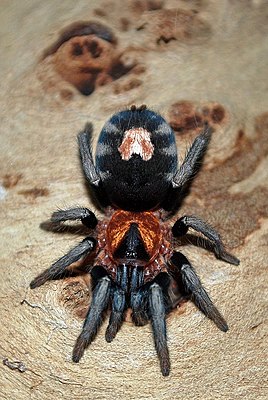Cyriocosmus elegans
| Cyriocosmus elegans | ||||||||||||
|---|---|---|---|---|---|---|---|---|---|---|---|---|

Cyriocosmus elegans , female |
||||||||||||
| Systematics | ||||||||||||
|
||||||||||||
| Scientific name | ||||||||||||
| Cyriocosmus elegans | ||||||||||||
| ( Simon , 1889) |
Cyriocosmus elegans is a spider from the tarantula family(Theraphosidae). Thespecies occurringin Central and South America is, like the other tarantulas of the genus Cyriocosmus, rather small and is one of the smallest tarantulas.
The English names of the species, based on the visual appearance, are Trinidad Dwarf Tiger Tarantula (translated roughly: "Trinidad Tiger Dwarf Tarantula ") and Valentine Tarantula .
features
Cyriocosmus elegans has a body length of about ten to fifteen millimeters, whereby the female, as with many spiders, usually remains somewhat larger than the male. The latter reaches a body length of twelve millimeters. The leg span of an adult female is 25 to 50 millimeters. With these dimensions, the species is one of the dwarf tarantulas . Various small tarantula species are grouped under this term, but most of them are not closely related and often do not even belong to the same subfamily.
The prosoma (front body) has a copper-colored basic color and in front a black triangle, which also includes the chelicerae (jaw claws). The legs are black and show a silver shimmer on the dorsal side. The basic color of the opisthosoma (abdomen) is also black. It is flanked by copper stripes and dorsally it is adorned with an equally copper-colored heart spot. Cyriocosmus elegans has stinging hairs that can be thrown at an attacker if there is danger, and is therefore one of the tarantulas that can be bombarded.
Similar species
Cyriocosmus elegans can be confused with some other species in the genus, but is generally smaller than most of the others. The female of C. elegans is very similar to those of the species C. fernandoinew and C. fasciatus , but can be distinguished from them by the size and shape of the spot on the opisthosoma and from other species of the genus by the four stripes on the flanks of the opisthosoma become. The male of C. elegans can be differentiated from all other members of the genus except for C. versicolor , C. bertae and C. leetzi by the presence of a paraembolic apophysis. The male of C. elegans differs from the males of C. versicolor and C. bertae by the striation on the dorsal side of the opisthosoma and from that of C. leetzi by a well-developed prolateral upper keel and the lack of a dark longitudinal ligament on the abdomen.
Occurrence
Cyriocosmus elegans is native to Venezuela and the West Indies . There she lives in the tropical rainforests and prefers to stay under stones, leaves or undergrowth.
Threat and protection
Cyriocosmus elegans is often found in their habitat and is not threatened. The IUCN does not count the stock. Possible factors that could endanger the populations would be the worldwide export of the species for the needs of terraristics and the decline in their habitats.
Way of life
Cyriocosmus elegans is one of the ground-dwelling tarantulas and, like all species in this family, is predominantly nocturnal. Especially at dusk it is most common outside of its shelter. Like many other terrestrial tarantulas, the species creates self-dug living tubes that are lined with spider silk and can reach up to 30 cm in depth. Like all tarantulas also hunts cyriocosmus elegans as lurking predators and captured other invertebrates that do not exceed the leg span of the spider.
Cyriocosmus elegans is not very aggressive and tries to flee when disturbed, instead of defending itself with a bite or its stinging hair. The intraspecific aggressiveness of the species is also much less pronounced than in other tarantulas, which can lead to the formation of groups. Since there is no interaction between the individuals, it is still not counted among the social spiders.
Reproduction
The mating of Cyriocosmus elegans takes place in the dry season. The reproductive behavior of the species is largely similar to that of other tarantulas. For courtship, the female drums with her pedipalps (in arachnids transformed extremities in the head area) on the ground in front of the female web. If this is willing to mate, it drums back accordingly. During mating, the male holds the female's chelicerae with his tibial apophyses and now transfers his sperm from his bulbi (male sex organs) to the epigyne (female sex organ). Some time after mating, the female makes an egg cocoon that contains 50 to 70 fertilized eggs. After a while, the young hatch, which then have a leg span of a few millimeters. The young spiders grow through several moults within a period of 10 months to a whole year. The entire lifespan of Cyriocosmus elegans is five to seven years.
Terrariums
Like many tarantulas, Cyriocosmus elegans is often kept as a pet in terrariums . This is due, among other things, to their robustness and easy care. In addition, due to its small body size, the species only needs a smaller dwelling than other tarantulas and, in addition, the low aggressiveness is seen as an advantage in keeping. However, one should note that the animals may not react aggressively, but rather shyly when disturbed and often flee immediately. It should also be borne in mind that the nocturnal spider can rarely be seen outside of its shelter during the day.
Systematics
Eugène Simon described the species as Hapalopus elegans in 1889 , but classified it in the genus Cyriocosmus in 1903 . The genus combination Cyriocosmus elegans was gradually used from 1945 and exclusively from 1973 under Rita Delia Schiapelli and Berta S. Gerschman de Pikelin . Synonyms of the kind are:
- Erythropoicila plana Fischel , 1927
- Chaetorrhombus semifasciatus Bücherl, Timotheo & Lucas , 1971
Individual evidence
- ↑ a b Cyriocosmus elegans (Simon, 1889) on Arachnophilia.de , accessed on February 25, 2020.
- ↑ a b c d e f g h i j k Cyriocosmus elegans (Simon, 1889) at the University of the West Indies , accessed February 25, 2020.
- ↑ a b c d e f Cyriocosmus elegans (Simon, 1889) on Ratgeber tarantulas , accessed on February 25, 2020.
- ↑ a b c C. S. Fukushima, R. Bertani, PI da Silva Junior: Revision of Cyriocosmus Simon, 1903, with notes on the genus Hapalopus Ausserer, 1875 (Araneae: Theraphosidae) , Zootaxa 846 (846), 2005, p. 1– 31, accessed February 25, 2020.
- ↑ a b Cyriocosmus elegans (Simon, 1889) in the WSC World Spider Catalog , accessed February 25, 2020.
- ↑ Cyriocosmus elegans (Simon, 1889) on Global Biodiversity Information Facility , accessed February 25, 2020.
literature
- CS Fukushima, R. Bertani, PI da Silva Junior: Revision of Cyriocosmus Simon, 1903, with notes on the genus Hapalopus Ausserer, 1875 (Araneae: Theraphosidae) , Zootaxa 846 (846), 2005, pp. 1-31.
Web links
- Cyriocosmus elegans in the World Spider Catalog
- Cyriocosmus elegans (Simon, 1889) on Global Biodiversity Information Facility
- Cyriocosmus elegans (Simon, 1889) on Tarantedia
- Cyriocosmus elegans (Simon, 1889) on Arachnophilia.de
- Cyriocosmus elegans (Simon, 1889) at the University of the West Indies
- Cyriocosmus elegans (Simon, 1889) on counselor tarantulas


